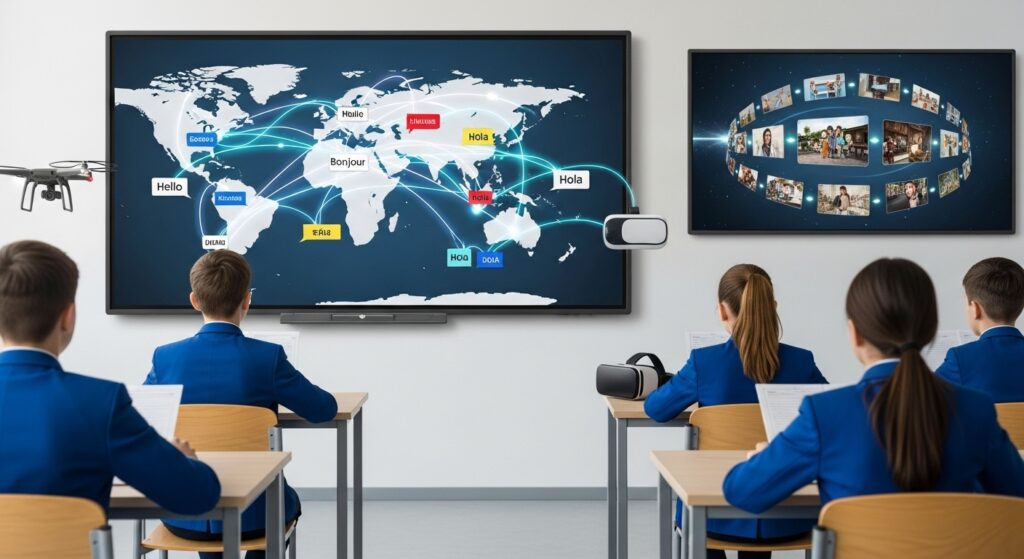In today’s rapidly evolving educational landscape, language acquisition is no longer confined to traditional classroom settings. The most effective language learners are those who embrace innovative approaches, blending traditional teaching with multimedia assisted language learning (MALL) to enhance comprehension, retention, and engagement.
This article explores the concept of multimedia assisted language learning, its practical applications, benefits, and why it represents the future of language education.
What is Multimedia Assisted Language Learning?
Multimedia assisted language learning (MALL) is an approach that integrates digital media—such as audio, video, interactive software, and online resources—into the process of learning a new language. By combining auditory, visual, and interactive elements, MALL creates a more immersive and effective learning environment.
Unlike traditional methods, which rely heavily on textbooks and rote memorization, MALL leverages technology to engage multiple senses simultaneously, allowing learners to internalize language patterns more naturally.
Why MALL Matters in Today’s Educational Landscape
With globalization and the rapid exchange of information, proficiency in multiple languages has become a critical skill. However, traditional language learning approaches often struggle to meet the needs of modern students, who are accustomed to multimedia-rich environments.
Multimedia assisted language learning bridges this gap by:
-
Enhancing student motivation through engaging content.
-
Providing authentic language exposure through videos, podcasts, and real-life simulations.
-
Allowing self-paced learning that accommodates diverse learning styles.
By adopting MALL, educators can make language learning more dynamic, inclusive, and effective.
The Core Principles of Multimedia Assisted Language Learning
At the heart of MALL is a commitment to interactive, learner-centered teaching. The approach emphasizes:
-
Multisensory Engagement: Learning through visual, auditory, and kinesthetic channels to reinforce comprehension.
-
Contextual Learning: Embedding language in authentic contexts using videos, dialogues, and interactive simulations.
-
Feedback and Assessment: Immediate feedback through apps and online platforms enhances accuracy and retention.
-
Collaboration: Encouraging learners to participate in group activities, discussion forums, and online projects.
This philosophy reflects the growing understanding that modern learners thrive in environments where technology complements pedagogy, rather than replacing it.
Practical Applications of Multimedia Assisted Language Learning
MALL can be applied in various ways across educational contexts, from primary schools to higher education and professional language courses. Some examples include:
-
Language Learning Apps: Platforms like Duolingo, Babbel, and Rosetta Stone integrate gamification, quizzes, and multimedia to create engaging lessons.
-
Video-Based Learning: Watching movies, tutorials, or instructional videos in the target language helps learners develop listening comprehension and cultural awareness.
-
Interactive Software: Programs with speech recognition, virtual role-play, and simulations provide hands-on language practice.
-
Online Collaboration: Learners connect with peers worldwide through video calls, discussion boards, and shared projects, fostering real-world communication skills.
By embedding multimedia into learning, MALL allows learners to practice reading, listening, speaking, and writing in a cohesive, integrated manner.
Benefits of Multimedia Assisted Language Learning
The adoption of MALL provides a range of cognitive, motivational, and practical benefits for learners:
-
Enhanced Retention: Combining visual, auditory, and interactive inputs improves memory and recall.
-
Greater Engagement: Multimedia resources make learning more enjoyable, increasing motivation and persistence.
-
Cultural Awareness: Exposure to authentic materials—such as films, music, and news—helps learners understand cultural context.
-
Personalized Learning: Technology allows learners to progress at their own pace, revisiting challenging topics as needed.
-
Flexibility: Students can access learning resources anytime, anywhere, supporting distance education and lifelong learning.
These benefits illustrate why MALL is not just a trend but a transformative approach in language education.
Influence in the Digital Age
In the digital era, MALL leverages tools that were unavailable in traditional classrooms, creating a new paradigm of learning:
-
Online Platforms: Interactive websites and apps provide structured courses, exercises, and multimedia content.
-
Virtual Reality (VR): Immersive VR environments simulate real-life situations, allowing learners to practice conversation in realistic contexts.
-
Artificial Intelligence (AI): AI-powered language tutors can adapt lessons based on learner performance, offering personalized support.
-
Social Media Integration: Platforms like YouTube and TikTok allow learners to consume authentic content and engage with native speakers.
By embracing these digital tools, MALL amplifies opportunities for learning, collaboration, and cultural exploration.
A Model for Future Language Learners
The rise of multimedia assisted language learning reflects broader shifts in educational expectations, particularly among Millennials and Gen Z. Today’s learners increasingly value:
-
Interactive Learning: Dynamic content that keeps them engaged and motivated.
-
Cultural Competence: Understanding context, idioms, and cultural nuances is as important as vocabulary.
-
Self-Directed Learning: Flexibility to explore content that aligns with personal interests and learning styles.
-
Global Connectivity: Opportunities to practice with peers worldwide through digital platforms.
MALL provides a blueprint for this next generation, showing how technology can enhance both language proficiency and global awareness.
Challenges and Opportunities
Like any modern educational approach, MALL presents both challenges and opportunities:
Challenges:
-
Digital Access: Not all learners have consistent access to devices or high-speed internet.
-
Overreliance on Technology: Multimedia should complement, not replace, human interaction and teacher guidance.
-
Content Quality: Not all multimedia resources are pedagogically sound, requiring careful curation.
Opportunities:
-
Hybrid Learning: Combining classroom instruction with MALL can maximize effectiveness.
-
Adaptive Learning: AI and analytics can help identify learner needs and tailor resources.
-
Global Collaboration: Learners can connect with peers across cultures, fostering linguistic and social growth.
By navigating these challenges thoughtfully, MALL can remain practical, scalable, and transformative.
Looking Ahead
As multimedia assisted language learning continues to expand, its potential for reshaping education is enormous. The future promises:
-
Greater integration of immersive technologies such as AR and VR to simulate real-world communication.
-
AI-driven personalized language coaching, adapting to individual learning styles and pace.
-
Increased cultural and linguistic diversity in digital content, making global languages accessible to more learners.
-
Sustainable, lifelong learning models that blend technology with traditional pedagogy for maximum impact.
In a world where communication across cultures is increasingly vital, MALL equips learners with the skills, confidence, and cultural understanding necessary to thrive.
Conclusion
Multimedia assisted language learning is more than a teaching method—it is a transformative approach that integrates technology, pedagogy, and culture. By engaging learners through sight, sound, and interaction, MALL makes language acquisition more effective, motivating, and globally relevant.
As educational institutions and learners embrace these tools, language learning becomes immersive, inclusive, and connected to real-world contexts. In this evolving landscape, MALL represents not just the future of language education but a model for how technology can enhance human learning across disciplines.
By exploring and adopting multimedia assisted language learning, educators and learners alike position themselves at the forefront of innovative, culturally aware, and technology-driven education.






